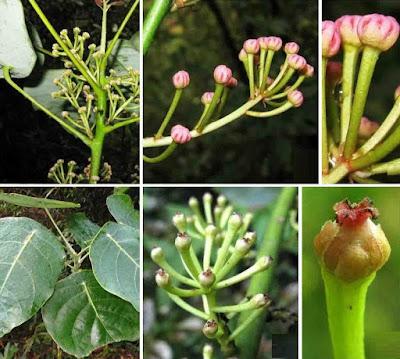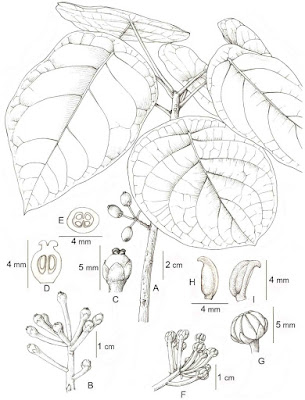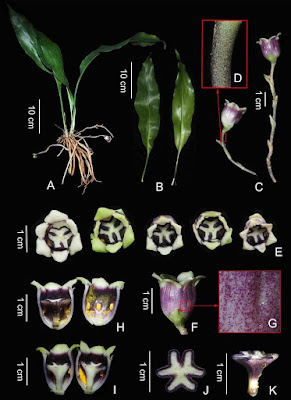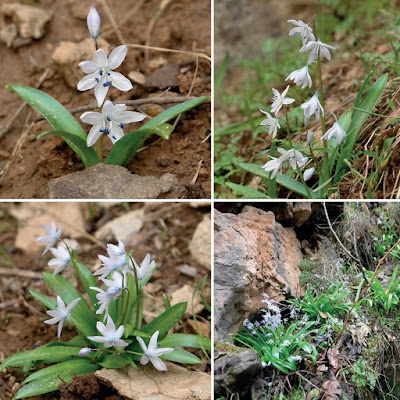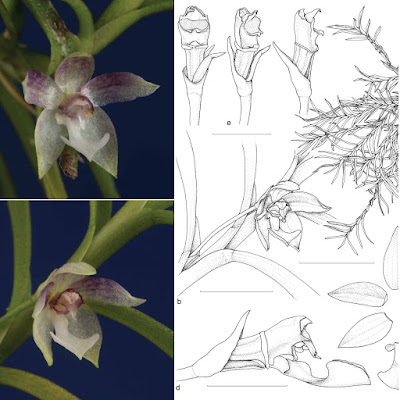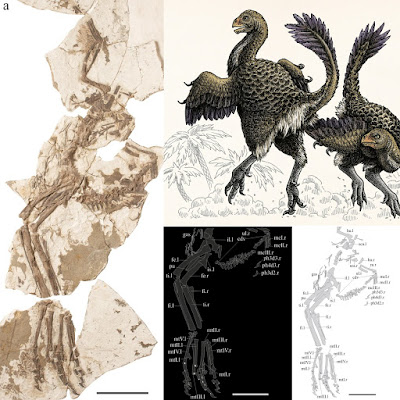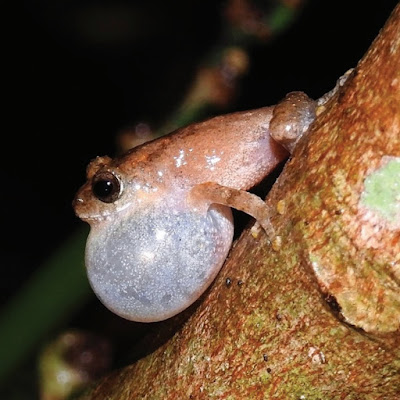[Most Recent Entries] [Calendar View]
Friday, April 17th, 2020
| Time | Event | ||||||
| 4:28a | [Botany • 2020] Daphniphyllum peltatum (Daphniphyllaceae) • A New Species from Limestone Areas in southwestern Guangxi, China
ABSTRACT Daphniphyllum peltatum Yan Liu & T. Meng, a new species of Daphniphyllaceae from southwestern Guangxi, China, is described and illustrated. The new species is mainly similar to D. calycinum Benth. in the shape of leaf blade, lunate anthers, elliptic drupes and the length of infructescence, but it can be easily distinguished by blue green branchlets, peltate leaves, obviously raised midvein and lateral veins on both surfaces. We also provide a key to all species of Daphniphyllum in China, and a table to distinguish the new species from D. calycinum. KEY WORDS: China, Daphniphyllaceae, Daphniphyllum peltatum, limestone flora, new taxa, southwestern Guangxi, taxonomy. Daphniphyllum peltatum Yan Liu & T. Meng, sp. nov. 盾葉虎皮楠 Diagnosis: Daphniphyllum peltatum is mainly similar to D. calycinum Benth. in the shape of leaf blade, lunate anthers, elliptic drupes and the length of infructescence, but can be easily distinguished from the latter by branchlets blue green (vs. grayish brown); base of leaf blade rounded, peltate (vs. base broadly cuneate, not peltate); pedicels of female flower 1-1.3 cm long (vs. 5-7 mm long); ovary ca. 3 mm long (vs. 1.5-2 mm long); drupe ca. 7 mm in diam. (vs. 3-6 mm in diam.). Etymology: The specific epithet is derived from the peltate leaf of this new species. Chinese name is proposed here as “盾葉虎皮楠”. Tao Meng, Dong-Xin Nong, Quan Yuan and Yan Liu. 2020. Daphniphyllum peltatum, A New Species of Daphniphyllaceae from Limestone Areas in southwestern Guangxi, China. Taiwania. 65(2); 232-236. taiwania.ntu.edu.tw/abstract.php?type=ab | ||||||
| 4:47a | [Botany • 2020] Aspidistra purpureomaculata (Asparagaceae) • A New Species of Aspidistra from Laos
Abstract Aspidistra purpureomaculata, a new species from Pakse, Laos, is described and illustrated. This new species resembles A. xuansonensis in the shape of perianth and stigma, but can be distinguished by its perianth tube colour mainly purple and stamens in the middle of the perianth tube. Aspidistra purpureomaculata is also similar to A. laongamensis in the shape of perianth and the position of stamens but is distinguishable by perianth lobes 6, pale green or white inside, and stigma 6-lobed. Detailed description is provided. Keyword: Asparagaceae, Aspidistra, new taxon, taxonomy, Laos Aspidistra purpureomaculata H.C. Xi, J.T. Yin & W.G. Wang, sp. nov. Diagnosis: The new species resembles Aspidistra xuansonensis N.Vislobokov in the shape of perianth tube and lobes and the shape of stigma, but can be distinguished by its leaf size (especially shorter petiole length), perianth tube colour mainly purple (vs. mainly white) and stamens position in the perianth tube (in the middle vs. at the lower part). Aspidistra purpureomaculata is also similar to Aspidistra laongamensis C. R. Lin & X. Y. Huang in the shape of perianth and the stamens in the middle of perianth tube but is distinguishable by perianth lobes 6, pale green or white inside (vs. usually 8, yellow), stigma 6-lobed (vs. usually 4-lobed). A detailed morphological comparison of these 3 species is presented in Table 1. Etymology: The specific epithet “purpureomaculata” refers to the purple-spotted flowers, peduncles and cataphylls of the new species. Distribution and Habitat: Currently known only from the type locality and found growing alongside a river at an elevation of ca. 300 m above sea level. Hou-Cheng Xi, Jian-Tao Yin, Xing-Da Ma and Wen-Guang Wang. 2020. Aspidistra purpureomaculata, A New Species of Aspidistra (Asparagaceae) from Laos. Taiwania. 65(2); 228-231. taiwania.ntu.edu.tw/abstract.php?type=ab | ||||||
| 5:47a | [Botany • 2020] Scilla hakkariensis (Asparagaceae: Scilloideae) • A New Species of Scilla L. from Hakkari (eastern Anatolia)
ABSTRACT Scilla hakkariensis, sp. nov. (Asparagaceae), described herein as a new species to science, is endemic to the eastern Anatolian region of Turkey. It is related to S. libanotica Speta and S. mischtschenkoana Grossh., but clearly differs from them based on the morphological differences presented in the species description. Specifically, it is easily distinguished from both of them by its seeds without elaiosome. In addition, the conservation status, a distribution map, and notes on the biogeography and ecology of the new species are given. KEY WORDS: Asparagaceae, Hakkari, Scilla, new species. Scilla hakkariensis Fırat & Yıldırım, sp. nov. Scilla hakkariensis, sp. nov. is related to S. libanotica Speta and S. mischtschenkoana Grossh. It differs from both of them by its seeds without elaiosome (elaiosome is not distinct on the raphe). Also Scilla hakkariensis, sp. nov. is easily separate from related species by the following features: tepal 10-15 (12.8±1.3) mm long and filaments 6-8 (7.2±0.8) mm long (14-20 [17.7±1.7] mm and 8-11 [9.2±1.2] mm in S. mischtschenkoana); tepals whitish to very pale pinkish-blue, styles 4-7 (5.3±1.3) mm long (light blue, 7-10 [8.4±1.4] mm in S. libanotica). Etymology. — The species epithet is derived from Hakkari province, where the new species was first discovered. Vernacular name. — Scilla hakkariensis, sp. nov., is called (Kurdish name) “Berfîne” by the local people of the Şemdinli district of Hakkari province. Mehmet Firat and Hasan Yildirim. 2020. Scilla hakkariensis, sp. nov. (Asparagaceae: Scilloideae): A New Species of Scilla L. from Hakkari (eastern Anatolia). Adansonia. 42(2); 89-94. DOI: 10.5252/adansonia2020v42a2 http://adansonia.com/42/2 | ||||||
| 3:22p | [Botany • 2020] Dichaea auriculata (Orchidaceae: Zygopetalinae) • A New and Unusual Species of Dichaea from Costa Rica
Abstract A new and florally unusual species of the genus Dichaea is described and illustrated from Costa Rica, where it is apparently endemic, and its relationships are discussed. Dichaea auriculata is compared with the group of species close to D. graminoides, from which it can be distinguished by the lip with a long isthmus, provided with two rounded auricles at the base, instead of the sessile lip typical of the group. It is also compared with another Costa Rican endemic in the same complex, D. gracillima, from which it can be distinguished by the autogamous, mostly cleistogamous, flowers, the 3-lobed lip with rounded basal lobes, the high keel along the lip isthmus, and the bifid ligule of the column. Notes on the habitat and the ecology of the new species are provided. Keywords: Dichaeopsis; Flora of Costa Rica; autogamy; new species; plant diversity; section Pseudodichaea
Dichaea auriculata Pupulin & Karremans, sp. nov. Species sectionis Pseudodichaeae, ab omnibus species Dichaeae Lindl. auriculis magis rotundatis et carina alta in basi labelli facile distinguenda; inter species foliis articulatis ovarioque glabro munitas (genus Dichaeopsem sensu Pfitzer vel coetum Dichaeae panamensis informaliter dictum), Dichaea gracillima C.Schweinf. in habito formaque et dimensione floris similis sed floribus plerumque autogamis labello distincte trilobo lobulis basalibus rotundatis, carina alta in isthmo labelli, ligula columnae bipartita recedit. Etymology. From the Latin auriculatus, provided with ears, in reference to the small, ear-like basal lobes of the lip, unique in the genus. Habitat & Ecology — Dichaea auriculata is known from a single population, found in the constantly wet and warm region of the Río Tuis, which drains into the Caribbean. Plants of D. auriculata have been observed on shaded branches of the lower canopy, on trees of secondary mature vegetation. Franco Pupulin and Adam P. Karremans. 2020. A New and Unusual Species of Dichaea (Orchidaceae: Zygopetalinae) from Costa Rica. Blumea - Biodiversity, Evolution and Biogeography of Plants. DOI: 10.3767/blumea.2020.65.01.06 | ||||||
| 3:44p | [Paleontology • 2019] Xingtianosaurus ganqi • A New Caudipterid from the Lower Cretaceous of China with Information on the Evolution of the Manus of Oviraptorosauria
Abstract Caudipteridae is a basal clade of Oviraptorosauria, all known species from the Early Cretaceous Jehol Biota of northeastern China. They were one of the first feathered dinosaur groups discovered, and possessed avian-like pennaceous remiges and rectrices. Their discovery provided significant information on early oviraptorosaurian evolution and the origins of birds and feathers. Here we describe a new caudipterid species Xingtianosaurus ganqi gen. et sp. nov. from the Lower Cretaceous Yixian Formation of Liaoning Province, China. This new taxon differs from other caudipterids by a small pleurocoel close to the dorsal edge of the lateral surface of the dorsal vertebrate centrum, a humerus longer than the scapula, a proportionally long ulna, a relatively small radiale angle, and a relatively short metacarpal I. The phylogenetic results shows X. ganqi is an early diverging caudipterid. It exhibits a mosaic morphology, providing new morphological information on early manual evolution of Oviraptorosauria, and giving new light on the evolution of radiale angle among Coelurosauria. Systematic palaeontology Oviraptorosauria Barsbold, 1976 Caudipteridae Zhou et Wang, 2000 Xingtianosaurus gen. nov Etymology: XingTian, a Chinese deity recorded in Shanhaijing who continued to fight even after his head had been cut off, in reference to the skull-less holotype; saurus, Greek for lizard. Type species: Xingtianosaurus ganqi Diagnosis: A caudipterid dinosaur distinguished from other caudipterid taxa by the following combination of characters: small pleurocoel close to the dorsal edge of the lateral surface of the dorsal vertebral centrum, humerus longer than the scapula, proportionally long ulna (as long as humerus), relatively small radiale angle (39°, compared to >48° in other oviraptorosaurs with known radiale angle), extremely short metacarpal I (<40% length of the metacarpal II), small ligament pits on the manual phalanges. Xingtianosaurus ganqi sp. nov. Etymology: Ganqi, the weapon of Xingtian recorded in Shanhaijing. Holotype: IVPP (Institute of Vertebrate Paleontology and Paleoanthropology) V13390 (Fig. 1). A partial skeleton, missing the skull, cervical vertebrae, anterior dorsal vertebrae and coracoids. Locality and horizon: Wangjiagou, Yixian County, Liaoning Province. The Dakangpu Bed (same horizon to Dawangzhangzi Bed) of Yixian Formation, Lower Cretaceous (Fig. 2). Rui Qiu, Xiaolin Wang, Qiang Wang, Ning Li, Jialiang Zhang and Yiyun Ma. 2019. A New Caudipterid from the Lower Cretaceous of China with Information on the Evolution of the Manus of Oviraptorosauria. Scientific Reports. 9, 6431. DOI: 10.1038/s41598-019-42547-6 | ||||||
| 3:46p | [Herpetology • 2020] Raorchestes rezakhani • A New Species of Cryptic Bush Frog (Anura, Rhacophoridae, Raorchestes) from northeastern Bangladesh
Abstract Raorchestes is a speciose genus of bush frogs with high diversity occurring in the Western Ghats of India. Relatively fewer species have been recorded across India, through Bangladesh, southern China, into Vietnam and Peninsular Malaysia. Many bush frogs are morphologically cryptic and therefore remain undescribed. Here, a new species, Raorchestes rezakhani sp. nov., is described from northeastern Bangladesh based on morphological characters, genetics, and bioacoustics. The 16S rRNA gene distinguished this species from 48 known species of this genus. Bayesian Inference and Maximum Likelihood analyses indicated that the new species was most similar to R. tuberohumerus, a species found in the Western Ghats, and to R. gryllus, a species found in Vietnam. Bioacoustics indicated that their calls were similar in pattern to most Raorchestes species, although number of pulses, duration of pulses, pulse intervals and amplitude differentiated it from a few other species. It is suggested that northeastern India, Bangladesh, northern Myanmar, and southern China represent important, relatively unexplored areas that could yield additional species of Raorchestes. Since many remaining habitat patches in Bangladesh are under severe threat from deforestation, efforts should be made to protect these last patches from further degradation. Keywords: Amphibian, bush frog, DNA, herpetofauna, Raorchestes rezakhani sp. nov. Raorchestes rezakhani sp. nov. Suggested English name: Reza Khan’s bush frog Etymology: We take great pleasure in naming the new species as a patronym for one of the pioneers in the field of wildlife research in Bangladesh, Dr. Mohammad Ali Reza Khan. Diagnosis: A species of Raorchestes having the following unique combination of characters: (1) relatively small size (adult males = 18.85–20.90 mm SVL); (2) head wider than long (HW/HL 1.55; range 1.53–1.56, N = 4); (3) dark brown, granular dorsum bearing small, horny spicules; (4) vomerine teeth absent; (5) single transparent vocal sac while calling; (6) snout projecting, sub-elliptical in ventral aspect, and subequal to or smaller than horizontal diameter of eye; (7) tympanum indistinct; (8) supratympanic fold weakly distinct; (9) finger and toe discs well developed and rounded; (FD IV 0.50–0.60, TD IV 0.56–0.65 mm); (10) both inner and outer metacarpal and metatarsal tubercles absent; (11) nostril is closer to tip of snout than to eye (NS 0.63–0.90, EN 1.10–1.25 mm); (12) Tongue without papilla (13) venter pale white, with minute dark gray flecks present in the vocal sac region. Details of these measurements are provided in Table 3.
Distribution and natural history: Raorchestes rezakhani sp. nov. was recorded from the semi-evergreen forests of northeastern Bangladesh. They were active with the onset of the rainy season in the month of April. We did not hear calls of this species after August. Frogs were found inside the primary and secondary forest mainly on the edge of streams and near man-made trails. They often use the hilly slopes during calling. Individuals perch on leaves and branches of small trees and on bamboo trunks (with diameters of 1.5–4 cm). Vocalizing individuals were perched 1–1.5 m above the forest floor. We usually heard the calls immediately after the sunset (ca. 1815 h in April) although calling activity started a little earlier when it was raining. Hassan Al-Razi, Marjan Maria and Sabir Bin Muzaffar. 2020. A New Species of Cryptic Bush Frog (Anura, Rhacophoridae, Raorchestes) from northeastern Bangladesh. ZooKeys. 927: 127-151. DOI: 10.3897/zookeys.927.48733 |
| << Previous Day |
2020/04/17 [Calendar] |
Next Day >> |
